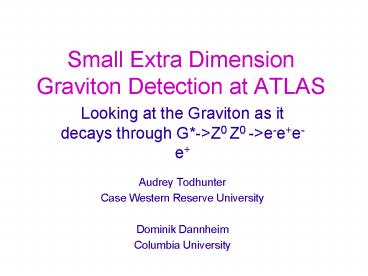Small Extra Dimension Graviton Detection at ATLAS - PowerPoint PPT Presentation
Title:
Small Extra Dimension Graviton Detection at ATLAS
Description:
Small Extra Dimension Graviton Detection at ATLAS – PowerPoint PPT presentation
Number of Views:45
Avg rating:3.0/5.0
Title: Small Extra Dimension Graviton Detection at ATLAS
1
Small Extra Dimension Graviton Detection at ATLAS
- Looking at the Graviton as it decays through
G-gtZ0 Z0 -gte-ee-e - Audrey Todhunter
- Case Western Reserve University
- Dominik Dannheim
- Columbia University
2
The Graviton
- Massive graviton resonances are predicted by
models using extra dimensions - -resonances could be well separated in mass
- The graviton couples universally
(ee,??,??,??,Z0Z0, etc) - -Products could be detected at ATLAS
- Analysis used the Randall-Sundrum model, which
predicts the mass of the first resonance by - mn xn(k/MPl)??
- We chose k/MPl0.01 to give resonances on the TeV
scale
3
- This analysis
- pp?G?Z0Z0?ee-ee-
- against a Standard Model background
- qq?Z0Z0?ee-ee-
- The branching ratio Br for Z0Z0?ee-ee- is only
3.43.4 11.56 for this decay process
4
Signal and Background Simulation
- -Pythia event generator
- -mass points at 300GeV, 500GeV, 700GeV, 1TeV, and
1.5TeV, as well background processes around each
point - -want to know how well these signals can be
detected at ATLAS? Geant4 used in a full
simulation of the ATLAS reconstruction
5
Properties of simulated signal and background
6
Particle Selection
- We can identify electrons by their
characteristics detected in the EM calorimeter
and the central tracker - Transverse energy eT gt 20 GeV
- Likelihood gt 0.9 being electron rather than pion
- 2ee- pairs in each entry
- - best combination of particles decided by
comparing reconstructed Z0 mass to known Z0 mass
(91.1GeV)
7
Invariant Z0 mass from a 300GeV signal from
electron pairs closest to Z0 mass within each
interaction
8
Graviton Reconstruction
- -electrons chosen for Z0 mass used to reconstruct
invariant G mass - -signal scaled for 100 fb-1 luminosity (1 year
running at design luminosity) - NEv (?Br) L
- imposing a weight factor on the number of
simulated events
9
Signal at 500GeV with a Gaussian fitsigma
parameter used to look at events within a mass
window of 3?
10
Signal and background added and fit
withp0e(-(x-p1)2/2p2 2 p3e(p4xp5)
11
(No Transcript)
12
(No Transcript)
13
(No Transcript)
14
Potential discovery of resonances from
G?Z0Z0?ee-ee- at ATLAS
- count number of signal and background events
within the 3? window - need to have Nsiggt5v (NBG) or Nsig gt 10 for a
statistically significant signal - number of events can be increased by raising
luminosity
15
Luminosity needed for Nsiggt5v (NBG) or Nsig gt 10
L100fb-1 one year running at design luminosity
16
Conclusions
- -for the process G?Z0Z0?ee-ee- the upper mass
limit is slightly below 700GeV - -higher discovery potential at increased
luminosity - -other decay channels are possible for the
graviton which may have higher upper limits for
detection































